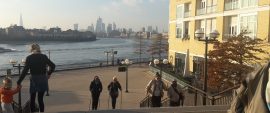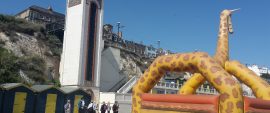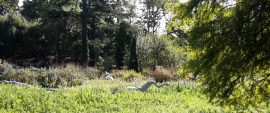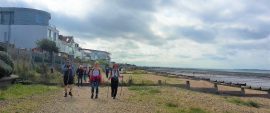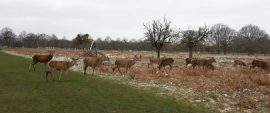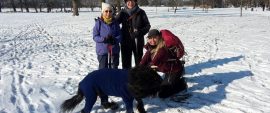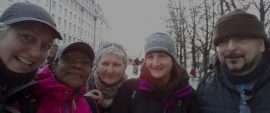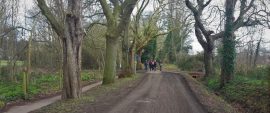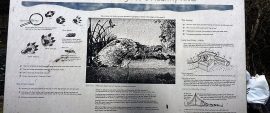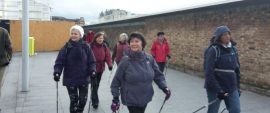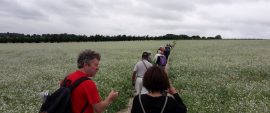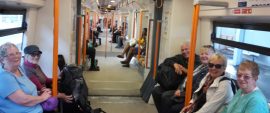Sea Kayak expedition day 7 – They’re shooting!

Before I set off on this trip I had planned very little. Just as well: I am learning now that whenever I do plan something, my plans will be thwarted anyway.
It started on day 3 with my plan of going to Whitstable for lunch, when a shivering sandbank got in my way. Then on Tuesday I had thought of going to Folkestone, when the wind was much stronger than expected, and I had to have a rest day in Dover. And today has not been different
It looked like a perfect day to get going again. The sun was shining, the wind was calm, but when I tried to set off it seemed half the beach had ended up in my skeg box. A skeg is similar to a fin under a surfboard or a sword under a sailing boat. I should be able to slide it down into the water to help my kayak stay on course when the wind tries to blow us in a different direction, and I should be able to slide it back in when I don’t need it. That way, I can also protect it when I land.
But now I am trying to leave, the grit in my skeg box is completely stuck, and I cannot move my skeg in or out. I grab my knife and slice it along the surface of the skeg to remove the grit. I push my kayak in the water, jump in and find that even that short slide had caused my skeg to get stuck again.
With James filming and poking fun at me, I get out, pull the boat back on the beach, remove the grit until there is movement in the skeg again. Finally I am in the kayak, the skeg is moving and I finally set off towards Folkestone. James is still laughing, but it feels good to be waved off by a new friend again. I might have set off on this expedition by myself, but I am sure meeting some wonderful people.

The cliffs towering high above me were more green and overgrown then the cliffs to the north of Dover, but still very impressive. I passed the first military zone of the day. This one looked impressive, but seemed the public. Fishermen were standing on the wall and people were walking their dogs.

I made good progress and by lunchtime I was in Hythe. I was hungry and needed to pee, so I decided to stop and find the public facilities.
My lunch break also gave me a chance to phone the information number of the Hythe firing range. Just after Hythe I would pass two military firing ranges. I had been dreading this bit, as I knew this stretch could really thwart my plans. The military are in charge of miles and miles of coastline, which can only be travelled if they are not shooting, as their practice shots get fired miles into the sea. The first range lies between Hythe and Dungeness, the second one between Dungeness and Rye Harbour.
During a long conversation with the range dispatcher, it became clear I couldn’t go any further until 4.30 pm. The guy told me that once I got on the water I’d better paddle fast, as they would only have a two-hour break before they would start shooting again.
He suggested it would be best if I would keep paddling once I cleared the Hythe Range. The Rye range had a night off, would be shooting all day tomorrow, starting at 8.30 in the morning.
With a bit of fast paddling, I cleared the Hythe range in 45 minutes and get congratulated by my army contact, when I call him on the VHF radio to tell him I am clear. He seems impressed.
With his words of warning in mind, I kept paddling fast, hoping to get past Dungeness and the Rye range. I kept looking at the Dungeness lighthouse. It was just a dot in the distance. I had been doing so well, but now the dot in the distance just didn’t want to grow into a lighthouse, no matter how hard I kept pushing on.

The water was flat and shimmered silvery underneath me. Clouds were moving in overhead, covering the moon. It would be a dark night. Finally, by around 9 pm, I reached the spit of Dungeness. Paddling on didn’t feel good. I had no idea where I could put up my tent later. The idea of paddling for another couple of hours and having to find a place to camp the dark didn’t appeal at all. I decided to pull my boat up alongside the fishing boats and to get up ridiculously early in the morning to try and clear the firing range before they would start shooting.

After a long day paddling it was hard work pulling my kayak up on the steep mountain of shingles. I was glad I hadn’t decided to paddle on, I don’t know if I could have done it after another 2 or 3 hours paddling. But every time I have to drag my week-old kayak over those shingles, my heart breaks a bit, so I rooted around the beach and found some wooden blocks. Grubby and full of oil, they are clearly used by the fishermen to put under their boats when they winch them up. I wished I could have used their winch instead of my weary muscles, but the blocks were better than the sharp rocks.
My camping spot on the shingles was eerily beautiful. I was all alone. Just me, a couple of crumbling fishing huts, rows of deserted fishing boats, a couple of gulls, a lighthouse in the distance and …. a monster of a nuclear power station!


Distance paddled: 39 km / 24 m/ 21 Nm
Total distance paddled so far: 214 km / 133 m / 116 Nm
